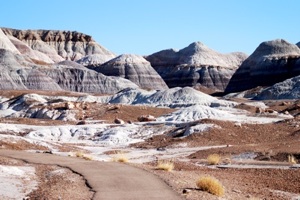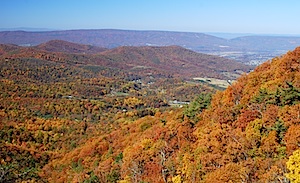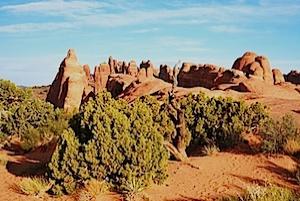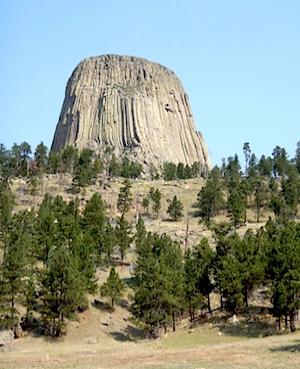History, stunning vistas, ancient cultures, and hallowed grounds, all can be found in the National Park System. And in the past 12 months, I was fortunate enough to experience all those settings.
Starting with a stop in Arches National Park in March and ending with a stay in Shenandoah National Park in October, I was able to appreciate the varied wonders of the park system. By year's end, I had added cancellations from eight new parks to my national parks Passport®, and also visited some old favorites.
The treks showcased the diversity of the National Park System, and demonstrated something most of us know: parks remain fascinating no matter how many times you visit and revisit them.
Looking for adventures in the parks? Consider rafting down the Green River through Dinosaur National Monument, hiking in Theodore Roosevelt National Park, or cycling through Badlands National Park. Hooked on history? Canyon de Chelly National Monument in Arizona has centuries of human history held in its sandstone walls, while Manassas National Battlefield in Virginia will school you on the early days of the Civil War, and 18th-century trade is explained at Fort Union National Historic Site in North Dakota.
Chances are that wherever you live, you'll find you're in reach of some units of the National Park System that will sate your search for adventure, history, culture.
Living roughly in the middle of the Rocky Mountains enables me to head in just about any direction and encounter a unit. In March I found myself heading out on a road trip through southern Utah and into Arizona. That time of year can be perfect for a southern swing, as major snowstorms are well-spaced, warm weather isn't unheard of, and crowds in the parks are scarce. At Arches, a park I've been to many times, the agenda was light, a review of the Devils Garden Campground and maybe a hike.
Heading through Arches National Park in mid-March, I figured I'd spend a night at the Devils Garden Campground. I also figured I'd have it all to myself. Boy was I wrong.
The landscape around Devils Garden Campground is captivating. Kurt Repanshek photo.So wrong was I that a week before I left home the 50-site campground was already sold out for the night I hoped to pitch my tent, a Monday night at that! In hindsight, though, I shouldn't have been surprised. Spring break in Utah and Colorado falls for many schools in mid-March, and for people well-familiar with the park, mid-March is a much, much better time to be camping in Devils Garden than July or August. That's when temperatures soar towards, and occasionally beyond, the century mark.
And I also found time for a hike.
While the more than 2,000 rock arches at Arches National Park might hold your kids' attention for a good period of time, sometimes you just have to get down and dirty to keep them happy. That's when you head to Sand Dune Arch.
In truth, the entire park is pretty much one big playground for youngsters. After all, how many places are there where they can climb up to, and through, much of the landscape? In the Windows Section of the park you and your kids can hike up to Turret Arch, and climb into the arch and down the other side. Ditto for North and South Windows which oppose Turret.
And I also had time to kick around Moab, a bit, and renew my acquaintance with this great national park gateway town. With no lodging in either Canyonlands or Arches national parks, Moab overflows with options, ranging from great B&Bs to ho-hum name-brand chains.
Head south of Moab on U.S. 191 and you'll find yourself passing more than a few units of the park system. There's the Needles District of Canyonlands National Park, the turnoff to Natural Bridges National Monument, another to Hovenweep National Monument, and then you drop into Arizona with another roster of parks.
My first stop in northeastern Arizona was at Canyon de Chelly National Monument, a portal into ancient cultures that have called the canyons here home going back 5,000 years. Although the monument was added to the National Park System in 1931 by President Herbert Hoover, the agreement left most of the landscape as the property of the Navajo Nation, and you need to hire a Navajo guide to lead you through the canyons.
Perry Yazzie rapidly works the Jeep's clutch in response to the dips in the dirt track, but the clutch nevertheless complains loudly from time to time, gnashing its metal teeth as we head deeper and deeper into Canyon de Chelly National Monument. The Jeep forges on as Yazzie takes us deeper into the past in a canyon that overflows with human history, reverence, and despair.
Though you can gaze down into the canyon from the monument's road, to reach the inner sanctum you must rely on one of the local Navajo tour guides. Although the monument was added to the National Park System in 1931 by President Herbert Hoover, the agreement left most of the landscape as the property of the Navajo Nation.
Tribal members such as Mr. Yazzie, whose family is one of about 40-50 Navajo families that own land on the canyon floor, continue to farm that land, raise livestock there in summer, and guide tours.
Not too far from Canyon de Chelly stands Hubbell Trading Post National Historic Site, a site that has been troubled in recent years by an ill-conceived National Park Service investigation into alleged charges of embezzlement against the Indian trader, Billy Malone. That episode, fortunately, is in the past, and the historic site's reputation is being rebuilt by Superintendent Lyn Carranza.
Heading further south of Hubbell led me to Petrified Forest National Park, a wonder of petrified wood, fossilized remains of dinosaurs, and a repository of prehistoric cultural artifacts.

The Blue Mesa Trail. Kurt Repanshek photo.
That visit produced not only a checklist for exploring the park, but hikes through the Crystal Forest, out to Agate House and along the Long Logs trail, and down into Blue Mesa.
There's much more to explore at Petrified Forest, and some issues that could significantly impact the park, issues we'll be exploring in the weeks and months ahead.
Not far to the west of Petrified Forest is Montezuma Castle National Monument, where a cliff dwelling dominates the unit.
One of the most accessible units of the National Park System has to be Montezuma Castle National Monument, which protects a roughly 1,000-year-old cliff dwelling less than 10 minutes off Interstate 17 in northern Arizona. Located not quite two hours north of Phoenix, and just 45 minutes south of Flagstaff, the monument is a small gem worth a visit. The Southern Sinagua people who built this five-story cliff dwelling chose their location wisely. They tucked their home into an alcove in the cliffside about 100 feet off the valley floor. From there they had protection from the elements, the south-facing dwelling was warmed in winter by the sun, and the height provided a great perspective of the surrounding landscape.
Early June produced a trip to North Dakota, thanks to that state's tourism department. Though considered out of the way by many, the state is rich in Western history. I discovered that with a visit to Knife River Indian Villages National Historic Site. I started out my visit with a short paddle down the Knife River with Superintendent Wendy Ross, a paddle that offered the perspective that was presented to an 18th century trapper or early 19th century explorer coming to the village.
Paddling the lazy flows of the Knife River, our approach to the Indian village that sent a young Indian woman west with Lewis and Clark could have been a day out of the past. It was early June, and already the river was sluggish, more a reflection of the dry winter rather than the normal flow. River banks rose high above on both shores, initially hiding a finger of what was the heart of trading on the Northern Plains in the early 1800s.
Cottonwoods reach out over the river, and there are green ash and willows. Beyond the banks, mixed-grass prairie runs, much like it did when Meriwether Lewis and Willam Clark arrived in the fall of 1804."

The Elkhorn Ranch setting, Roosevelt's homestead. Kurt Repanshek photo.
Of course, any trip to North Dakota demands a visit to Theodore Roosevelt National Park in the southwest corner. My time spent there not only opened my eyes to the rugged beauty of this park, but also to the looming spectre of "fracking" for fossil fuels and what that could do to the park. And I visited the setting along the Little Missouri River that a young Theodore Roosevelt called home for a few years.
Before he developed his barrel chest, and before he so strongly developed his conservation ethos, Theodore Roosevelt came to the Dakota Territory to hunt bison. It was the first foray in a landscape and way of life that, he would later admit, "took the snob" out of him.
Considering the year -- 1883 -- and the frontier landscape, that's not surprising. Here, in the rutted and rugged badlands that rise up around the Little Missouri River, the young Mr. Roosevelt felt himself pretty much out of his element, having grown up in New York City. But his thirst for the West was greatly visible to his companions, and his initial discomfort with the setting was recognized by Roosevelt himself.
"There were all kinds of things that I was afraid of at first, ranging from grizzly bears to mean horses and gunfighters," he noted in a diary entry in 1883. "But by acting as if I was not afraid, I gradually ceased to be afraid."
I also had some time for hiking, such as along the Ridgeline Nature Trail, the Upper Caprock Coulee Trail, and the Wind Canyon Trail.
Perhaps hardest to visit in North Dakota, due to its location in the state's northwest corner, is Fort Union Trading Post National Historic Site. For lovers of the fur trapping days, this site is a must-see. Much of the fort has been reconstructed, but some of the original foundation stones still exist. And stepping into the the "Trade Room" is stepping into the past; its walls are covered with heavy robes and blankets, its floor with casks of flour, sugar, and coffee, its shelves with eating utensils, cups and plates.
Late June brought a family reunion and wedding that led me to Devils Tower National Monument, Mount Rushmore National Memorial, and Badlands National Park. While most visitors to Devils Tower are content to simply gaze up at the geologic stub from the visitor center or maybe hike to its base, the 3-mile-long entrance road is an appealing challenge for road cyclists.
The turnoff from Wyoming 24 onto Wyoming 110 takes you on a gentle downhill that curves left to the park's entrance station. It's from there that the climb to the tower's base starts. You cross the Belle Fourche on a bridge, roll past a black-tailed prairie dog town where the locals bark at you, then the park campground, and enter the forest that wraps the monument's base.
Devils Tower can't be missed as you pedal into the park. Kurt Repanshek photo.You can meander a bit here to add prairie dogs and still more shots of the looming tower to your camera, or simply to read the placards that discuss the geology at work. The steep ride to the top takes you through the forest, offers a few pullouts to peer at the tower, and delivers you to the visitor center.
There's no need to rush up this climb. You can take a break to admire the tower or to take on some water. There is wildlife here -- I spotted a whitetail deer in the forest -- and birds calling. Once you reach the top, if it's summer you'll want to escape the idling tour buses with their mongering hordes. Slipping into the visitor center won't necessarily accomplish that, but you can stamp your Passport to Your National Parks, check out the books and souvenirs, and top off your water bottles.
Badlands National Park also proved exceptional for cycling.
Cool air, soft light, and smooth pavement greeted us as we rode into Badlands National Park, a park whose name suggests unforgiving ruggedness but which offers a sweet ride that leads you through those badlands and across windswept prairie.
The early hour -- we were up by 5:30 a.m. and pedaling by 7 a.m. -- was a key ingredient of the ride, as my wife and I didn't want to be overcome by the 100-degree temperatures that would envelope Badlands by midday. Another bonus to the cool air was the empty pavement: we had the road to ourselves.
Though Dinosaur National Monument is best-known for its paleontological treasures, the landscape is pretty incredible in its own right. A unique perspective on that landscape can be made floating literally down river, but also figuratively into the past, in the eddies of Major John Wesley Powell, on a river trip down the Green River through the Gates of Lodore.
If you ever sat down to list the units of the National Park System that are misunderstood and under-appreciated, Dinosaur National Monument would be near the top. That realization can't be ignored if you've floated either the Yampa or Green rivers that cleave into and expose the underbelly of Dinosaur. That thought first came to me when I drifted down the Yampa with friends back in 2009, and was reinforced in late July during a four-day trip down the Green with Holiday River Expeditions.
Floating through the Canyon of Lodore, past Echo Park and massive Steamboat Rock, and then into Whirlpool Canyon and on through Split Mountain, dinosaurs were the last thing on my mind.
September rewarded me with a trip with my wife to Yellowstone National Park, a park we've been to many times and yet one that still has surprises and secrets to uncover. Among the surprises was watching Grand Geyser erupt for more than 20 minutes, followed by Castle Geyser putting on its own show. The secrets were exposed after we ventured a short distance into the backcountry to watch Imperial and Spray geysers put on a show, and to explore the Monument Geyser Basin, an overlooked jewel in a most unusual location.
My last park outing for the year brought me to Virginia in the fall to visit family and Shenandoah National Park as well as Manassas National Battlefield Park. Shenandoah is an old favorite, a park I first visited during my youth growing up in New Jersey, and more recently as a destination to hike along the Appalachian National Scenic Trail for a ways.

The view from the Lewis Falls overlook is down into the Shenandoah Valley. Kurt Repanshek photo.
This year, a stay at Big Meadows Lodge gave me time for more hiking, down to Lewis Falls and to Dark Hollow Falls.
But the visit also left me curious about the state of the park system's historic lodges and how they're maintained.
At Manassas I walked the battlefield that brought to our country the realization that Civil War is ugly, as contributing writer Danny Bernstein pointed out after her own visit there in 2011.
By year's end, I was left with great memories of parks, parks that already are demanding repeat visits to explore the wonders they hold not only in their landscapes, but in their cultural and historic resources.



 Support Essential Coverage of Essential Places
Support Essential Coverage of Essential Places






